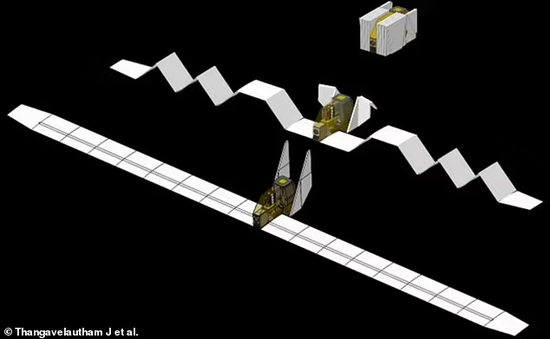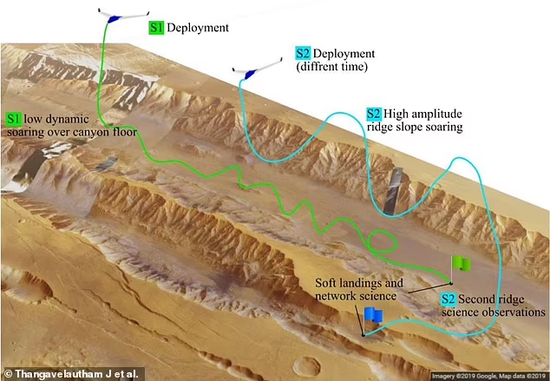Currently, NASA scientists have developed a glider that can soar on the surface of Mars.It can fly like an albatross for daysonce it is put into use, this unengine glider can be used to collect data on the atmosphere and geology of Mars. It weighs 5 kilograms, has a wingspan of 3.35 meters, and is about the size of an albatross.
▲ The picture shows the research team conducting a test launch of an early version of the glider in Arizona. During the launch, the glider was connected to the balloon and finally landed slowly on the ground.
This Mars glider can be sent to the surface of Mars by microsatellite, and then unfold the folded wings,Flying using only wind energy, its unique flight mode allows it to use wind energy to fly around Martian geological structuresfor example: canyons and volcanoes.
It is reported that the Mars glider is a prototype made by NASA planetary scientists and aviation experts at the University of Arizona. They were tested in the desert region of the earth (simulating the terrain of Mars), and the glider was sent into the earth’s atmosphere using balloons.
“Using the Mars Glider as a reconnaissance platform, crews can control the glider to Interesting and very cool area.”

▲ The newly designed Mars glider contains a series of navigation sensors, as well as cameras, temperature and gas sensors to collect information on the Martian atmosphere and landforms.
At present, 8 probes in Mars orbit are in normal operation, photographing the Martian surface with a resolution of 0.33 meters per pixel. In addition, 3 rovers are crossing the flat sandy surface of the Martian surface. Map small areas with greater accuracy.
However, the conditions within a 336-kilometer radius of the rover’s location, changes in the Martian climate, and large-scale geological features such as mountains are exactly what scientists are interested in, and further investigation and research are urgently needed. In 2021, NASA will deploy the “Wit” helicopter on the surface of Mars, designed to explore the Martian environment, but the helicopter can fly for up to 3 minutes at a time.
According to “Aerospace Magazine”, the Mars glider has the advantage of staying in the air longer and using its flight, temperature and gas sensors, as well as cameras and other equipment to comprehensively survey the environment. Dr Kling said: “The Mars Glider survey area is the intersection between the surface and the atmosphere, this is the area where dust is collected and sent into the atmosphere, where trace gases mix, and where mountains-canyons regulate a lot of wind, it’s just us There hasn’t been a lot of relevant data available before.”

▲ Scientists have proposed using the “Mars 2020” rover to carry gliders into, descend and land on the surface of Mars.
The research team wants NASA to fund a “ride mission” that would send a Mars glider to Mars aboard a rover. The glider can be carried by CubeSats, which are about the size of a phone sheet, and are carried by large space probes.
Once the glider enters the Martian atmosphere, it is released, either unfolding like origami or expanding like a swimming pool toy. It is reported that the US research team has carried out extensive mathematical modeling of the glider’s flight pattern based on climate data from Mars. It will use several different flight methods, including: simple static flight with sufficient vertical wind, or “dynamic” flight”.

▲ The glider can be released in the Martian atmosphere, and then spread its wings like origami.
Like an albatross on a long flight, dynamic flight uses horizontal wind speeds that increase with terrain height to enhance flight advantage, a phenomenon more common on the surface of Mars. The Mars Glider flies in an S-pattern, similar to a skier’s speed skiing downhill.
But instead of slowing down each time the glider changed direction, it gained speed with a slightly upward flight angle in the slow-moving low winds.
When the glider encounters faster, higher-altitude winds, it turns 180 degrees, allowing the high-speed wind to push it into flight at a slight downward angle. As it gradually runs out of energy, it repeats the following: Flying in S-mode, allowing it to fly for several days at a time, collecting energy in the Martian atmosphere.
“It’s pretty much something people see to believe,” said study co-author Jekan Thanga of the University of Arizona. Scientists are also exploring the use of balloons or airships to carry gliders The possibility of aircraft, which can descend slowly and take advantage of the best wind conditions, especially in areas of high interest to scientists, gliders can even fly back on balloons or airships to continue multiple space exploration missions .
After the glider lands, it will continue to transmit information about the Martian atmosphere to the spacecraft, essentially becoming a Martian weather station. At present, weather stations around the world provide information to meteorologists, and all relevant meteorological data are continuously fed back into the weather prediction computer model. A retired glider, no matter if the survey mission is completed as planned, or what is wrong with Cong, may become a similar network node of the Mars system.
“If we run out of flight energy, or our inertial sensors suddenly fail for some reason, we hope Scientific survey work can continue, and from a planetary science perspective, space exploration missions continue.”

▲ The picture shows the deployment of two different gliders (S1 and S2), their unique flight patterns can use the wind to fly around geological structures, such as: canyons and volcanoes.
This summer, the Mars Glider prototype flew at an altitude of 4,572 meters above Earth, where the atmosphere is thinner and the flight conditions are closer to Mars. Professor Sergey Shkarayev, co-author of the study and the University of Arizona’s Micro Vehicle Laboratory, said: “We can use Earth as a laboratory to study the flight to Mars, about flight trajectories, potential docking and docking. Systems etc. still need to be studied in depth, but we hope that the Mars glider is in a few years, not a few decades!”
.
[related_posts_by_tax taxonomies=”post_tag”]
The post Scientists design a Mars glider with a wingspan of 3.35 meters that can fly for several days appeared first on Gamingsym.
